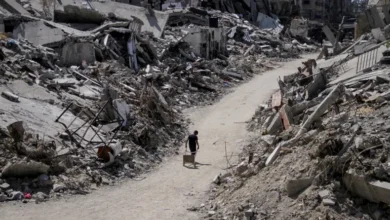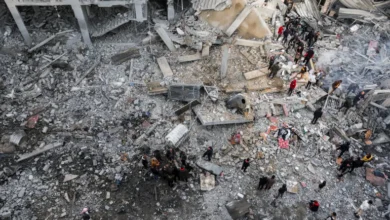What are ‘dragon drones’, Ukraine’s latest weapon against Russia?

Ukraine is adding little-known incendiary weapons to its armoury in its battle to fend off the ongoing Russian invasion, including “fire-spitting” drones reminiscent of dragons.
On Wednesday, Ukraine’s Defence Ministry posted videos on the social media platform X showing a Ukrainian drone raining down what appeared to be fire – but was molten metal – on forested positions presumed to be hiding Russian units.“A ‘dragon drone’ in the direction of Kharkiv”, the post from the ministry read, referring to Ukraine’s second-largest city, which has been the target of repeated Russian bombing.
Analysts say the weapon is a new and innovative introduction of an age-old weapon into the strategy of a Ukrainian military that has shown its growing proficiency in using small drones. Here’s what to know about the new “dragon drones”:
What are ‘dragon drones’ made of?
Dragon drones carry a substance called thermite. The mixture is made from metal powder – most often aluminium – and powdered iron oxide or rust.
Thermite is not explosive, but generates heat at such extreme temperatures – more than 2,200 degrees Celsius (4,000 degrees Fahrenheit) – that it burns through and damages nearly any material – clothing, trees and foliage, even military-grade vehicles. It can also burn underwater.
Used on humans, the weapon could be fatal, or cause extensive burns and bone damage. It could also lead to respiratory issues and psychological trauma for survivors.
Combining thermite with high-precision drones that can bypass traditional defences makes dragon drones “highly effective” and “dangerous”, according to the United Kingdom-based anti-war advocacy organisation Action on Armed Violence (AOAV).
Dragon drones tend to be low-flying because thermite is more effective when it’s in close contact with the target. Aside from delivering significant damage on their own, the weapons are also likely aiding Ukrainian units with reconnaissance missions. With foliage cover burned off, follow-up bombing campaigns are likely to be more precise, analysts say.
Some of the drones are believed to be developed by Ukrainian startup Steel Hornets, a private unmanned weapons systems manufacturer. The company’s thermite offerings include a light weapon it claims can burn through 4mm metal in under 10 seconds.
The United States military also produces thermite grenades, but though Washington is a principal supplier of weapons to Ukraine, it is unclear if the US supplies thermite-grade weapons to Kyiv.
Is using thermite legal?
Thermite’s destructive effects are similar to those of other incendiary substances like white phosphorus and napalm, designed to cause damage through burn or respiratory injury.
It’s not illegal to use weapons like dragon drones on military targets in warfare. However, it’s against international law to use incendiary weapons on civilians. It’s also illegal to use them on military targets inside populated areas, or on forested areas – unless the green cover is believed to be hiding military objects.
In general, the use of these substances is discouraged because the fires they produce are hard to contain, and they could affect civilians while also causing massive environmental damage, according to the United Nations Office for Disarmament Affairs.
Ukrainian units have so far used thermite on military targets, AOAV notes.
Russian units also appear to have used the substance. It was possibly used in March 2023 on civilian targets in the eastern Ukraine town of Vuhledar, according to the AOAV.










